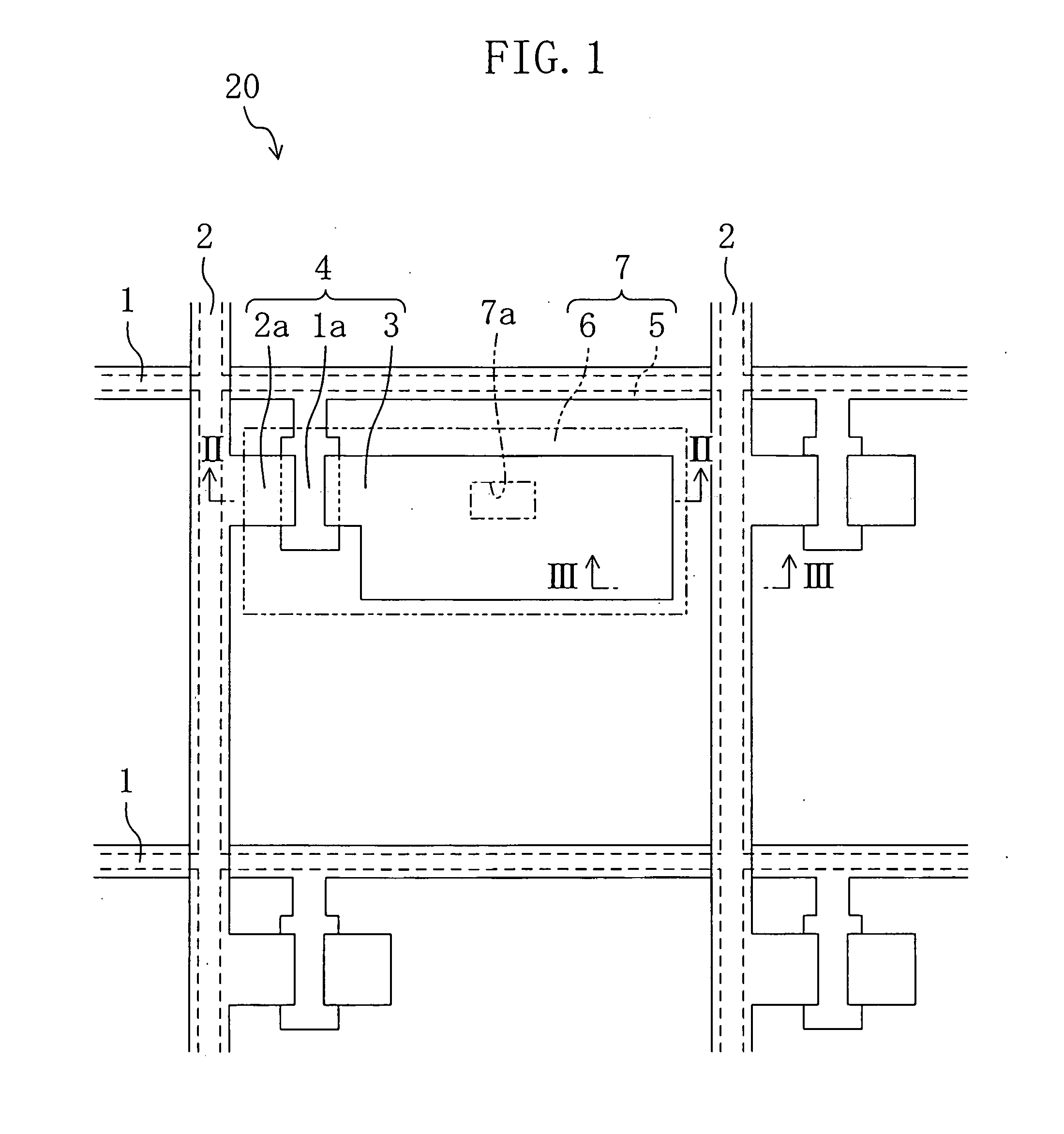Method for manufacturing conductive element substrate, conductive element substrate, method for manufacturing liquid crystal display, liquid crystal display and electronic information equipment
a technology of conductive elements and substrates, applied in the direction of identification means, instruments, static indicating devices, etc., can solve the problems of affecting the display quality, and bringing about electrolytic corrosion, so as to achieve the effect of high film strength, and reducing the etch ra
- Summary
- Abstract
- Description
- Claims
- Application Information
AI Technical Summary
Benefits of technology
Problems solved by technology
Method used
Image
Examples
embodiment 1
[0156] Hereinafter, a liquid crystal display of Embodiment 1 of the present invention will be described.
[0157]FIG. 1 is a schematic plan view of an active matrix substrate 20 for forming a liquid crystal display 50 according to Embodiment 1 of the present invention. FIG. 2 is a schematic sectional view of the liquid crystal display 50 cut along the line II-II shown in FIG. 1. FIG. 3 is a schematic sectional view of the active matrix substrate 20 cut along the line III-III shown in FIG. 1, illustrating a section of the edge portions of two adjacent pixels.
[0158] The liquid crystal display 50 includes the active matrix substrate 20, a counter substrate 30 opposed to the active matrix substrate 20 and a liquid crystal layer 40 sandwiched between the substrates 20 and 30.
[0159] As to the active matrix substrate 20, a plurality of gate lines 1 extending parallel to each other and a plurality of source lines 2 extending parallel to each other are arranged on a glass substrate 10 and th...
embodiment 2
[0218] A liquid crystal display according to Embodiment 2 of the present invention will be described below.
[0219] The liquid crystal display according to Embodiment 2 and an active matrix substrate for manufacturing the liquid crystal display are substantially the same in plane structure and sectional structure as those described in Embodiment 1 except the manufacturing method thereof. Therefore, in the following embodiment, explanation is given principally of a method of manufacturing the liquid crystal display, in particular, the step of manufacturing the active matrix substrate.
[Step of Manufacturing Active Matrix Substrate]
[0220] Hereinafter, explanation is given of the step of manufacturing an active matrix substrate according to Embodiment 2 of the present invention with reference to the drawings. The step includes a TFT formation step, a laminated conductive film formation step and a reflecting electrode formation step. FIGS. 11 to 13 are schematic sectional views correspo...
embodiment 3
[0261]FIG. 22 is a sectional view of a major part illustrating a schematic configuration of an electrode wiring substrate (conductive element substrate) according to Embodiment 3.
[0262] As shown in FIG. 22, the electrode wiring substrate 107 includes a glass substrate 101 provided with an IZO layer (second conductive metal layer) 104 which is formed as an uppermost layer having a lower etch rate and an aluminum (Al) layer (first conductive metal layer) 103 and a molybdenum (Mo) layer (first conductive metal layer) 102 which are formed as a lower layer having a higher etch rate. When viewed in cross section, the uppermost IZO layer (second conductive metal layer) 104 is more narrowed in the horizontal direction than the underlying Al layer (first conductive metal layer) 103 and Mo layer (first conductive metal layer) 102. The thus obtained layered structure has a cross section which is substantially tapered upward from the closest layer to the substrate, thereby providing a layered ...
PUM
| Property | Measurement | Unit |
|---|---|---|
| thickness | aaaaa | aaaaa |
| light energy | aaaaa | aaaaa |
| thickness | aaaaa | aaaaa |
Abstract
Description
Claims
Application Information
 Login to View More
Login to View More - R&D
- Intellectual Property
- Life Sciences
- Materials
- Tech Scout
- Unparalleled Data Quality
- Higher Quality Content
- 60% Fewer Hallucinations
Browse by: Latest US Patents, China's latest patents, Technical Efficacy Thesaurus, Application Domain, Technology Topic, Popular Technical Reports.
© 2025 PatSnap. All rights reserved.Legal|Privacy policy|Modern Slavery Act Transparency Statement|Sitemap|About US| Contact US: help@patsnap.com



